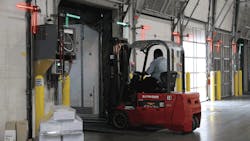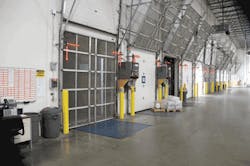Compete: Green-Lighting Safety at the Docks
Trailer creep is one of the most dangerous and most common hazards at a loading dock. It happens when a lift truck operator enters and exits an air-ride trailer. The repeated impact causes the trailer to edge away from the dock. For every inch of vertical movement (up or down), a trailer can experience an inch of horizontal movement.
Others hazards include early departure, trailer pop-up, trailer upending and landing-gear collapse. Each of these issues can happen while a forklift operator is busy moving loads in and out of the trailer.
Another concern at the loading dock involves communication. To ensure the safety of everyone at the dock during the loading and unloading process, truck drivers and loading dock personnel need to communicate. Whether it is an employee on the approach placing wheel chocks, a forklift operator entering and exiting the trailer, or the semi-truck driver backing up the trailer, communication is critical.
Emerson Climate Technologies—providers of HVAC and refrigeration solutions for residential, industrial, and commercial applications—was interested in improving dock safety at its 130,000 square foot distribution center in Greenfield, Ind. Employees here had been hand-chocking trucks and manually locking out air lines to ensure trailers stayed in place during loading and unloading at the facility's 30 docks. While these docks processed 25-30 truckloads carrying more than $1.2 million of product daily, supervisors were noticing a lack of clear communication between the drivers and loading dock personnel.
"My main goal for installing a new system was to protect our employees," says Rob Lee, operations/process improvement manager for Emerson Climate Technologies. "We used to put the responsibility on the driver to ensure the truck was locked. Or, you had to brave the weather to see what the status was on the truck."
Emerson looked at moving to automatic trailer restraints using a rotating hook to engage a trailer's rear impact guard. This secures a trailer to the loading dock to help prevent the vertical and horizontal trailer movement that can lead to trailer separation accidents. Along with that, it looked at ways of ensuring clear communication between truck drivers, forklift operators and dock personnel.
Once the system was installed at Emerson, it not only improved worker safety, but added to productivity by eliminating manual checks.
"The near mishaps we were having are a thing of the past," says Lee. "I can walk through the warehouse and, seeing all the green lights, know each of the trucks is being unloaded or loaded securely."
Troy Bergum is product manager for Rite-Hite Products Corp. (www.ritehite.com).

